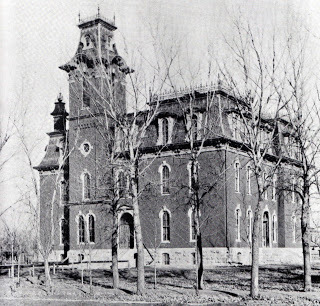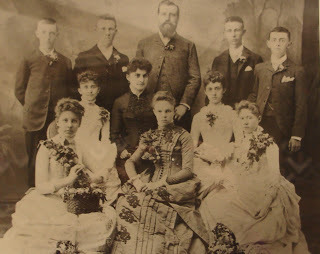High School in 1889
I'm reading a history of my home town as part of the research for next year's book, The Shadow of a Name. As I read, I've been creating a timeline of what happened when ... because I don't want to have my main character riding a horse-drawn trolley that didn't exist, or living in a part of the county that was populated only by wolves at the time. Just this evening, I've been adding the growth of the school system to my timeline, and I read something amazing:
 "Thehigh school curriculum comprises four parallel courses of three years each, theEnglish, the Latin, the German, and the Classical. These courses includeinstruction in algebra, book-keeping, geometry, botany, human physiology,physical geography, chemistry, physics, geology, English composition, wordanalysis, technical grammar, orthoepy, elocution, history and development ofEnglish literature, rhetoric, political economy, civil government, elements ofcommercial law, general history, three years each in Latin, Greek, and German.It will be seen that the public schools furnish a good practical education,well rounded out. 9 instructors.
"Thehigh school curriculum comprises four parallel courses of three years each, theEnglish, the Latin, the German, and the Classical. These courses includeinstruction in algebra, book-keeping, geometry, botany, human physiology,physical geography, chemistry, physics, geology, English composition, wordanalysis, technical grammar, orthoepy, elocution, history and development ofEnglish literature, rhetoric, political economy, civil government, elements ofcommercial law, general history, three years each in Latin, Greek, and German.It will be seen that the public schools furnish a good practical education,well rounded out. 9 instructors.
Anotable feature of the high school is a series of lectures on subjects directlyor indirectly connected with the course of study, given by persons prominent ineducational circles, and occurring once or twice per week throughout the year.Among the lecturers have been the Governor of Nebraska, and other Stateofficers, the Chancellor and other members of the faculty of the StateUniversity, lawyers, ministers and physicians of Lincoln, and the instructorsof the high school."
Does that course of study amaze anyone else? I remember my mother, who was born in 1913, saying that elocution was her favorite subject ... in 8th grade. I don't know any 8th graders who would even know what that is. I had to look it up. It's "the study and practice of oral delivery, including the control of both voice and gesture."
And ... orthoepy? a. The study of the pronunciation of words. b. The study of the relationship between the pronunciation of words and their orthography.
Well, now I have to look up orthography. This is getting embarrassing: the art of writing words with the proper letters, according to accepted usage; correct spelling.
 Lincoln's 1889 graduating class was about three times the size of the one pictured at the left. Still, I imagine our graduates dressed much the same. I love the flowers and the general "feel" of the photo, which says to me that they were proud of what they'd accomplished and they were making the day memorable.
Lincoln's 1889 graduating class was about three times the size of the one pictured at the left. Still, I imagine our graduates dressed much the same. I love the flowers and the general "feel" of the photo, which says to me that they were proud of what they'd accomplished and they were making the day memorable.
I wonder how many of those flowers ended up pressed and treasured for years to come. Did any of those young women go on to higher education? What opportunities lay before them? Whatever came their way, I wonder if they used their orthography, orthoepy, and elocution?
As to the high school portrayed above, that is the Lincoln, Nebraska high school, built in 1873. Historian James McKee says that "the trees, it was quickly pointed out, were not for shade or decoration. In the parents' haste to locate the school, they had chosen a site so far to the east of the city that a green belt was needed to protect the building from prairie fires ... Well into the next decade many parents would not allow their children to walk to school in winter for fear that they might be attacked by wild animals."
Honestly, the more I learn about "the good old days," the happier I am that all I do is write about them.
--Stephanie

 "Thehigh school curriculum comprises four parallel courses of three years each, theEnglish, the Latin, the German, and the Classical. These courses includeinstruction in algebra, book-keeping, geometry, botany, human physiology,physical geography, chemistry, physics, geology, English composition, wordanalysis, technical grammar, orthoepy, elocution, history and development ofEnglish literature, rhetoric, political economy, civil government, elements ofcommercial law, general history, three years each in Latin, Greek, and German.It will be seen that the public schools furnish a good practical education,well rounded out. 9 instructors.
"Thehigh school curriculum comprises four parallel courses of three years each, theEnglish, the Latin, the German, and the Classical. These courses includeinstruction in algebra, book-keeping, geometry, botany, human physiology,physical geography, chemistry, physics, geology, English composition, wordanalysis, technical grammar, orthoepy, elocution, history and development ofEnglish literature, rhetoric, political economy, civil government, elements ofcommercial law, general history, three years each in Latin, Greek, and German.It will be seen that the public schools furnish a good practical education,well rounded out. 9 instructors.Anotable feature of the high school is a series of lectures on subjects directlyor indirectly connected with the course of study, given by persons prominent ineducational circles, and occurring once or twice per week throughout the year.Among the lecturers have been the Governor of Nebraska, and other Stateofficers, the Chancellor and other members of the faculty of the StateUniversity, lawyers, ministers and physicians of Lincoln, and the instructorsof the high school."
Does that course of study amaze anyone else? I remember my mother, who was born in 1913, saying that elocution was her favorite subject ... in 8th grade. I don't know any 8th graders who would even know what that is. I had to look it up. It's "the study and practice of oral delivery, including the control of both voice and gesture."
And ... orthoepy? a. The study of the pronunciation of words. b. The study of the relationship between the pronunciation of words and their orthography.
Well, now I have to look up orthography. This is getting embarrassing: the art of writing words with the proper letters, according to accepted usage; correct spelling.
 Lincoln's 1889 graduating class was about three times the size of the one pictured at the left. Still, I imagine our graduates dressed much the same. I love the flowers and the general "feel" of the photo, which says to me that they were proud of what they'd accomplished and they were making the day memorable.
Lincoln's 1889 graduating class was about three times the size of the one pictured at the left. Still, I imagine our graduates dressed much the same. I love the flowers and the general "feel" of the photo, which says to me that they were proud of what they'd accomplished and they were making the day memorable. I wonder how many of those flowers ended up pressed and treasured for years to come. Did any of those young women go on to higher education? What opportunities lay before them? Whatever came their way, I wonder if they used their orthography, orthoepy, and elocution?
As to the high school portrayed above, that is the Lincoln, Nebraska high school, built in 1873. Historian James McKee says that "the trees, it was quickly pointed out, were not for shade or decoration. In the parents' haste to locate the school, they had chosen a site so far to the east of the city that a green belt was needed to protect the building from prairie fires ... Well into the next decade many parents would not allow their children to walk to school in winter for fear that they might be attacked by wild animals."
Honestly, the more I learn about "the good old days," the happier I am that all I do is write about them.
--Stephanie
Published on January 20, 2012 00:13
No comments have been added yet.



